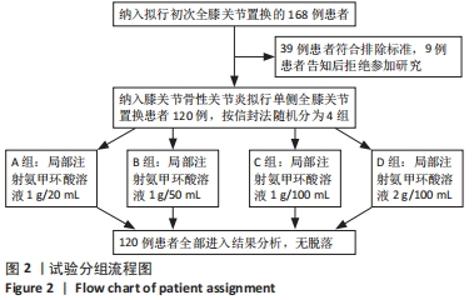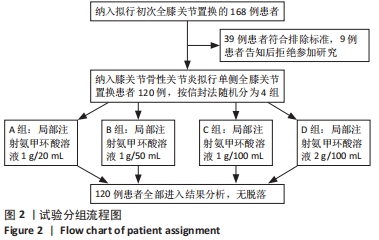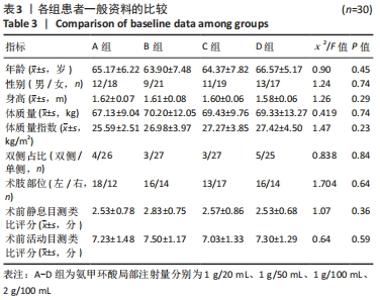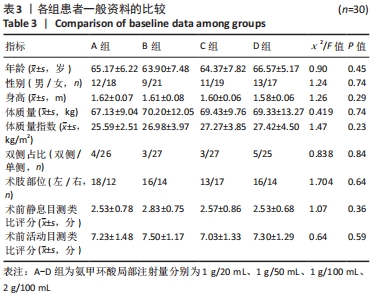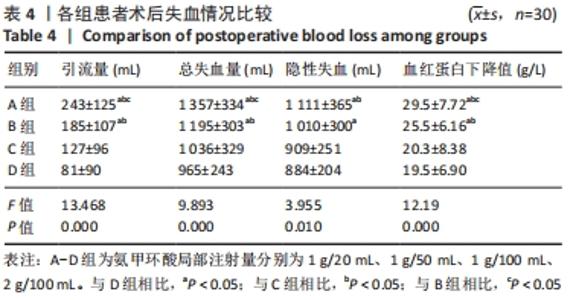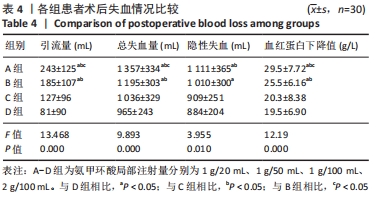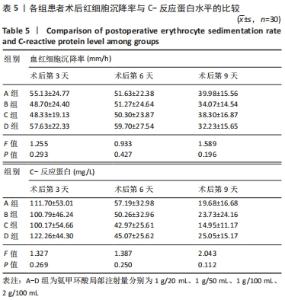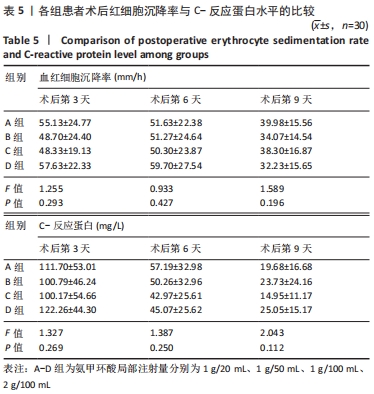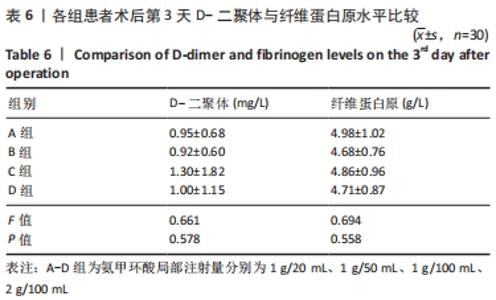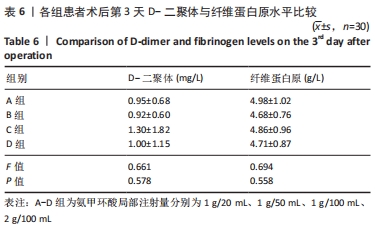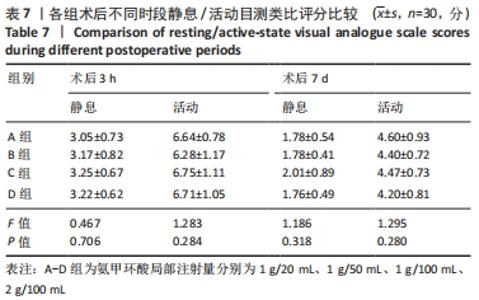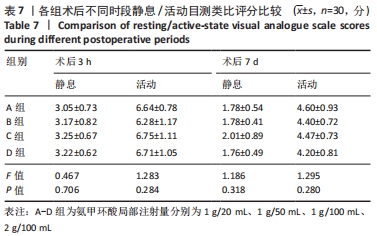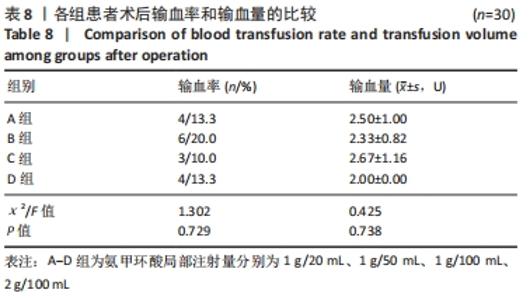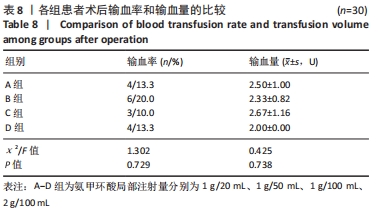Chinese Journal of Tissue Engineering Research ›› 2022, Vol. 26 ›› Issue (33): 5303-5310.doi: 10.12307/2022.806
Previous Articles Next Articles
Intra-articular tranexamic acid at different volumes and doses affects blood loss during total knee arthroplasty
Liu Jinlei, Yin Li, Zhang Yi, Wang Haitao, Lu Yingzi
- Department of Orthopedics, the First Affiliated Hospital of Zhengzhou University, Zhengzhou 450000, Henan Province, China
-
Received:2021-08-18Accepted:2021-10-11Online:2022-11-28Published:2022-03-30 -
Contact:Yin Li, MD, Chief physician, Master’s supervisor, Department of Orthopedics, the First Affiliated Hospital of Zhengzhou University, Zhengzhou 450000, Henan Province, China -
About author:Liu Jinlei, Master, Department of Orthopedics, the First Affiliated Hospital of Zhengzhou University, Zhengzhou 450000, Henan Province, China -
Supported by:the National Natural Science Foundation of China (Youth Fund), No. 81702663 (to ZY); Key Scientific Research Project Plan of Higher Education Institutions in Henan Province, No. 20A310022 (to YL)
CLC Number:
Cite this article
Liu Jinlei, Yin Li, Zhang Yi, Wang Haitao, Lu Yingzi. Intra-articular tranexamic acid at different volumes and doses affects blood loss during total knee arthroplasty[J]. Chinese Journal of Tissue Engineering Research, 2022, 26(33): 5303-5310.
share this article
Add to citation manager EndNote|Reference Manager|ProCite|BibTeX|RefWorks
| [1] CANOVAS F, DAGNEAUX L. Quality of life after total knee arthroplasty. Orthop Traumatol Surg Res. 2018;104(1S):S41-S46. [2] 高福强,李子剑,张克,等.人工关节置换术后隐性失血计算方法的初步探析[J].中华外科杂志,2011,49(12):1144-1147. [3] MA J, HUANG Z, SHEN B, et al. Blood management of staged bilateral total knee arthroplasty in a single hospitalization period. J Orthop Surg Res. 2014;9:116. [4] TO J, SINHA R, KIM SW, et al. Predicting Perioperative Transfusion in Elective Hip and Knee Arthroplasty: A Validated Predictive Model. Anesthesiology. 2017;127(2):317-325. [5] LEMAIRE R. Strategies for blood management in orthopaedic and trauma surgery. J Bone Joint Surg Br. 2008;90(9):1128-1136. [6] SEHAT KR, EVANS RL, NEWMAN JH. Hidden blood loss following hip and knee arthroplasty. Correct management of blood loss should take hidden loss into account. J Bone Joint Surg Br. 2004;86(4):561-565. [7] 覃健,余存泰,徐中和,等.全髋关节及全膝关节置换术后隐性失血的临床影响[J].中华骨科杂志,2006,26(5):323-326. [8] BEDARD NA, PUGELY AJ, LUX NR, et al. Recent Trends in Blood Utilization After Primary Hip and Knee Arthroplasty. J Arthroplasty. 2017;32(3):724-727. [9] WU J, ZHOU YQ, DENG JH, et al. Ideal intraarticular application dose of tranexamic acid in primary total knee arthroplasty: a prospective, randomized and controlled study. Ann Transl Med. 2020;8(21):1353. [10] TSUKADA S, KUROSAKA K, NISHINO M, et al. Intraoperative Intravenous and Intra-Articular Plus Postoperative Intravenous Tranexamic Acid in Total Knee Arthroplasty: A Placebo-Controlled Randomized Controlled Trial. J Bone Joint Surg Am. 2020;102(8):687-692. [11] FILLINGHAM YA, RAMKUMAR DB, JEVSEVAR DS, et al. Tranexamic Acid Use in Total Joint Arthroplasty: The Clinical Practice Guidelines Endorsed by the American Association of Hip and Knee Surgeons, American Society of Regional Anesthesia and Pain Medicine, American Academy of Orthopaedic Surgeons, Hip Society, and Knee Society. J Arthroplasty. 2018;33(10):3065-3069. [12] 中华医学会骨科学分会关节外科学组.骨关节炎诊疗指南(2018年版)[J].中华骨科杂志,2018,38(12):705-715. [13] DYSART S, SNYDER MA, MONT MA. A Randomized, Multicenter, Double-Blind Study of Local Infiltration Analgesia with Liposomal Bupivacaine for Postsurgical Pain Following Total Knee Arthroplasty: Rationale and Design of the Pillar Trial. Surg Technol Int. 2016;30:261-267. [14] 赖一豪.局部应用氨甲环酸对全膝关节置换术后失血影响的研究[D].昆明:昆明医科大学,2017. [15] NADLER SB, HIDALGO JH, BLOCH T. Prediction of blood volume in normal human adults. Surgery. 1962;51(2):224-232. [16] GROSS JB. Estimating allowable blood loss: corrected for dilution. Anesthesiology. 1983;58(3):277-280. [17] ZHANG X, MA D, PAN J, et al. Effects of Different Applications of Tranexamic Acid on Perioperative Blood Transfusion Rate and Postoperative Pain in Unilateral Total Knee Arthroplasty. Adv Ther. 2021;38(2):1143-1154. [18] TAI TW, LIN CJ, JOU IM, et al. Tourniquet use in total knee arthroplasty: a meta-analysis. Knee Surg Sports Traumatol Arthrosc. 2011;19(7): 1121-1130. [19] MUSALLAM KM, TAMIM HM, RICHARDS T, et al. Preoperative anaemia and postoperative outcomes in non-cardiac surgery: a retrospective cohort study. Lancet. 2011;378(9800):1396-1407. [20] FRIEDMAN R, HOMERING M, HOLBERG G, et al. Allogeneic blood transfusions and postoperative infections after total hip or knee arthroplasty. J Bone Joint Surg Am. 2014;96(4):272-278. [21] 周宗科,翁习生,曲铁兵,等.中国髋、膝关节置换术加速康复--围术期管理策略专家共识[J].中华骨与关节外科杂志,2016,9(1):1-9. [22] LEI Y, XIE J, XU B, et al. The efficacy and safety of multiple-dose intravenous tranexamic acid on blood loss following total knee arthroplasty: a randomized controlled trial. Int Orthop. 2017;41(10): 2053-2059. [23] LI GH, DING LM, SUN L, et al. Tranexamic Acid Combined with Compression Bandage Following Total Knee Arthroplasty Promotes Blood Coagulation: A Retrospective Analysis. Biomed Res Int. 2020; 2020:2739560. [24] CAO G, HUANG Q, HUANG Z, et al. The efficacy and safety of multiple-dose oral tranexamic acid on blood loss following total hip arthroplasty: a randomized controlled trial. Int Orthop. 2019;43(2):299-305. [25] CLAEYS MA, VERMEERSCH N, HAENTJENS P. Reduction of blood loss with tranexamic acid in primary total hip replacement surgery. Acta Chir Belg. 2007;107(4):397-401. [26] PORTER SB, WHITE LJ, OSAGIEDE O, et al. Tranexamic Acid Administration Is Not Associated With an Increase in Complications in High-Risk Patients Undergoing Primary Total Knee or Total Hip Arthroplasty: A Retrospective Case-Control Study of 38,220 Patients. J Arthroplasty. 2020;35(1):45-51.e3. [27] ZHANG S, XIAO C, YU W, et al. Tranexamic acid safely reduces hidden blood loss in patients undergoing intertrochanteric fracture surgery: a randomized controlled trial. Eur J Trauma Emerg Surg. 2020;46(1):11-21. [28] FILLINGHAM YA, RAMKUMAR DB, JEVSEVAR DS, et al. The Efficacy of Tranexamic Acid in Total Knee Arthroplasty: A Network Meta-Analysis. J Arthroplasty. 2018;33(10):3090-3098.e1. [29] MOSKAL JT, CAPPS SG. Intra-articular Tranexamic Acid in Primary Total Knee Arthroplasty: Meta-analysis. J Knee Surg. 2018;31(1):56-67. [30] WEI W, DANG S, DUAN D, et al. Comparison of intravenous and topical tranexamic acid in total knee arthroplasty. BMC Musculoskelet Disord 2018;19(1):191. [31] GUO P, HE Z, WANG Y, et al. Efficacy and safety of oral tranexamic acid in total knee arthroplasty: A systematic review and meta-analysis. Medicine (Baltimore). 2018;97(18):e0587. [32] 许宏,裴福兴.口服氨甲环酸在全膝关节置换术中的研究[J].中国骨与关节杂志,2017,6(12):903-907. [33] KIM YH, PANDEY K, PARK JW, et al. Comparative Efficacy of Intravenous With Intra-articular Versus Intravenous Only Administration of Tranexamic Acid to Reduce Blood Loss in Knee Arthroplasty. Orthopedics. 2018;41(6):e827-e830. [34] PENG ZHANG MM, JIFENG LI MM, XIAO WANG MM. Combined versus single application of tranexamic acid in total knee and hip arthroplasty: A meta-analysis of randomized controlled trials. Int J Surg. 2017;43:171-180. [35] XIONG H, LIU Y, ZENG Y, et al. The efficacy and safety of combined administration of intravenous and topical tranexamic acid in primary total knee arthroplasty: a meta-analysis of randomized controlled trials. BMC Musculoskelet Disord. 2018;19(1):321. [36] ZHANG S, WANG C, SHI L, et al. Multi-route applications of tranexamic acid to reduce blood loss after total knee arthroplasty: a randomized controlled trial. Medicine (Baltimore). 2019;98(30):e16570. [37] POERAN J, RASUL R, SUZUKI S, et al. Tranexamic acid use and postoperative outcomes in patients undergoing total hip or knee arthroplasty in the United States: retrospective analysis of effectiveness and safety. BMJ. 2014;349:g4829. [38] 张少云,谢锦伟,黄强,等.全膝关节置换术后多次静脉应用氨甲环酸对纤溶活性及炎症反应的影响[J].中华骨科杂志,2017,37(23): 1483-1489. [39] MA QM, HAN GS, LI BW, et al. Effectiveness and safety of the use of antifibrinolytic agents in total-knee arthroplasty: A meta-analysis. Medicine (Baltimore). 2020;99(20):e20214. [40] FILLINGHAM YA, RAMKUMAR DB, JEVSEVAR DS, et al. Tranexamic acid in total joint arthroplasty: the endorsed clinical practice guides of the American Association of Hip and Knee Surgeons, American Society of Regional Anesthesia and Pain Medicine, American Academy of Orthopaedic Surgeons, Hip Society, and Knee Society. Reg Anesth Pain Med. 2019;44(1):7-11. [41] JULES-ELYSEE KM, TSENG A, SCULCO TP, et al. Comparison of Topical and Intravenous Tranexamic Acid for Total Knee Replacement: A Randomized Double-Blinded Controlled Study of Effects on Tranexamic Acid Levels and Thrombogenic and Inflammatory Marker Levels. J Bone Joint Surg Am. 2019;101(23):2120-2128. [42] YANG JQ, YANG L, TAN JS, et al. Reduction of Blood Loss by Intra-articular Injection of Tranexamic Acid Combined with Knee and Hip Flexion at 45 During Primary Total Knee Arthroplasty: A Randomized Controlled Trial. Orthop Surg. 2020;12(6):1835-1842. [43] DURGUT F, ERKOCAK OF, AYDIN BK, et al. A comparison of the effects on postoperative bleeding of the intra-articular application of tranexamic acid and adrenalin in total knee arthroplasty. J Pak Med Assoc. 2019;69(3):325-329. [44] Bruce-Brand R, Dragomir R, Baker J, et al. Cerebrovascular infarction following bilateral total knee arthroplasty and tranexamic acid administration. Acta Orthop Belg. 2013;79(3):351-354. [45] MOTIFIFARD M, TAHRIRIAN MA, SANEIE M, et al. Low Dose Perioperative Intravenous Tranexamic Acid in Patients Undergoing Total Knee Arthroplasty: A Double-Blind Randomized Placebo Controlled Clinical Trial. J Blood Transfus. 2015;2015:948304. [46] AGARWALA S, JHAVERI M, MENON A. Advantages of clamping and drainage over continuous drainage in a total knee arthroplasty. J Clin Orthop Trauma. 2020;11(1):133-135. [47] BENJAMIN JB, COLGAN KM. Are Routine Blood Salvage/Preservation Measures Justified in All Patients Undergoing Primary TKA and THA. J Arthroplasty. 2015;30(6):955-958. [48] KOSINS AM, SCHOLZ T, CETINKAYA M, et al. Evidence-based value of subcutaneous surgical wound drainage: the largest systematic review and meta-analysis. Plast Reconstr Surg. 2013;132(2):443-450. [49] CAO JG, WANG L, LIU J. The use of clamped drainage to reduce blood loss in total hip arthroplasty. J Orthop Surg Res. 2015;10:130. [50] TAI TW, JOU IM, CHANG CW, et al. Non-drainage is better than 4-hour clamping drainage in total knee arthroplasty. Orthopedics. 2010;33(3): e133-e141. [51] 马德思,曲铁兵,潘江,等.同期双侧膝关节置换术不同途径局部应用氨甲环酸的随机对照研究[J]. 中华关节外科杂志(电子版), 2016,10(3):265-270. |
| [1] | Huang Hao, Hong Song, Wa Qingde. Finite element analysis of the effect of femoral component rotation on patellofemoral joint contact pressure in total knee arthroplasty [J]. Chinese Journal of Tissue Engineering Research, 2022, 26(6): 848-852. |
| [2] | Yuan Jing, Sun Xiaohu, Chen Hui, Qiao Yongjie, Wang Lixin. Digital measurement and analysis of the distal femur in adults with secondary knee valgus deformity [J]. Chinese Journal of Tissue Engineering Research, 2022, 26(6): 881-885. |
| [3] | Zhou Jianguo, Liu Shiwei, Yuan Changhong, Bi Shengrong, Yang Guoping, Hu Weiquan, Liu Hui, Qian Rui. Total knee arthroplasty with posterior cruciate ligament retaining prosthesis in the treatment of knee osteoarthritis with knee valgus deformity [J]. Chinese Journal of Tissue Engineering Research, 2022, 26(6): 892-897. |
| [4] | Wang Shaoling, Wang Yanxue, Zheng Yaochao, Yu Shaojun, Ma Chao, Wu Shaoling. Feasibility of ultrasound-guided intra-articular injection in rabbit hip joint [J]. Chinese Journal of Tissue Engineering Research, 2022, 26(5): 657-662. |
| [5] | Quan Honglei, Zheng Jiejiao, Feng Youyan, Zhang Jie, Zhu Yinghui. Early hip abductor training to improve balance and walking ability after total knee arthroplasty [J]. Chinese Journal of Tissue Engineering Research, 2022, 26(33): 5311-5316. |
| [6] | Song Wei, Zhang Yaxin, Jia Dazhou, Sun Yu. Adjective application of dexamethasone combined with furosemide for early pain and swelling after total knee arthroplasty [J]. Chinese Journal of Tissue Engineering Research, 2022, 26(33): 5317-5322. |
| [7] | Li Kai, Liu Zhendong, Li Xiaolei, Wang Jingcheng. Risk factors for recurrent prosthesis dislocation after total hip arthroplasty through posterolateral approach [J]. Chinese Journal of Tissue Engineering Research, 2022, 26(3): 354-358. |
| [8] | Pan Hao, Zhao Huihui, Wang Jiangjing, Wang Feng, Wang Peng, Shi Qiuling, Guo Jin, Li Lin, Liu Guoqiang. Comparison of kinematic alignment and mechanical alignment to guide gait after total knee arthroplasty [J]. Chinese Journal of Tissue Engineering Research, 2022, 26(3): 365-370. |
| [9] | Qu Pengfei, Wang Huisheng, Li Xi. Correlation between blood loss during primary total knee arthroplasty and hypoalbuminemia and hypocalcemia after arthroplasty [J]. Chinese Journal of Tissue Engineering Research, 2022, 26(3): 376-382. |
| [10] | Jin Herong, Cui Jingbin, Shao Cang. Materials of interbody fusion cage: advantages and focus of clinical application [J]. Chinese Journal of Tissue Engineering Research, 2022, 26(22): 3592-3597. |
| [11] | Cao Fuyang, Xu Jianzhong, Lu Shitao, Tan Jun, Jiang Xu, Yang Meng, Shi Jianming, Chang Yingjian. Autologous, mixed and ligament advanced reinforcement system ligaments reconstruction of anterior cruciate ligament: evaluation of bone tunnel enlargement value, ligament growth factor and knee function [J]. Chinese Journal of Tissue Engineering Research, 2022, 26(21): 3281-3290. |
| [12] | Liu Fatai, Yang Jinshun, Zhong Weibin. Application of three-dimensional printed osteotomy guide plate in knee arthroplasty in osteoarthritis patients with concomitant femoral deformity [J]. Chinese Journal of Tissue Engineering Research, 2022, 26(15): 2312-2316. |
| [13] | Xia Peige, Yin Li, Wang Haitao, Zhang Yi, Qiao Renqiu, Kong Zhiheng, Zhao Hongbo, Shi Xiangyu. Effect of knee ligamentous laxity on patient satisfaction after total knee arthroplasty: a medium to long-term follow-up [J]. Chinese Journal of Tissue Engineering Research, 2022, 26(15): 2323-2329. |
| [14] | Zhao Chi, Xu Hui, Kang Bingxin, A Xinyu, Xie Jun, Sun Songtao, Shen Jun, Xiao Lianbo, Shi Qi. Tuina prevents deep venous thrombosis of the lower limbs after total knee arthroplasty [J]. Chinese Journal of Tissue Engineering Research, 2022, 26(15): 2330-2336. |
| [15] | Wang Jinjun, Deng Zengfa, Liu Kang, He Zhiyong, Yu Xinping, Liang Jianji, Li Chen, Guo Zhouyang. Hemostatic effect and safety of intravenous drip of tranexamic acid combined with topical application of cocktail containing tranexamic acid in total knee arthroplasty [J]. Chinese Journal of Tissue Engineering Research, 2021, 25(9): 1356-1361. |
| Viewed | ||||||
|
Full text |
|
|||||
|
Abstract |
|
|||||
